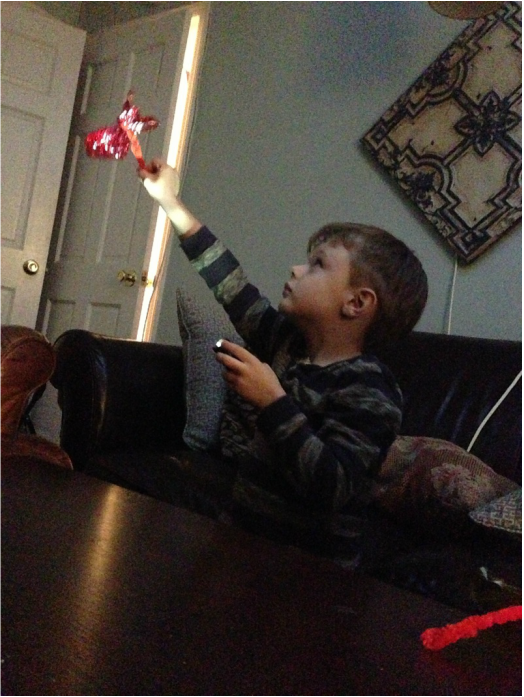Playing with movement and balance If you've spent five minutes with a young child recently, you'll have noticed that they almost never, ever stop moving except when they're asleep. Movement is one of the primary ways that young children explore their world and learn about their own bodies. Babies, especially, are learning new ways to move and balance almost every month. Here are some fun activities that you can do at home to capitalize on your child's love of movement.
Two Feet, Two Hands This activity is great for toddlers learning simple numbers and balance skills. Ask your child to make a shape with their body that has "two fee and two hands" on the floor. Then, change the combination by asking for "one foot, one hand." Get as creative as you can and challenge your child's physical dexterity and problem solving skills. BONUS TIP: If you do this project in tandem with your child, you can use even more number combinations - "three feet and four hands" is suddenly possible! Stepping Stones This is a variation of the "hot lava" game that we all used to play. Designate one area of your room as the river, and the goal of this game is to get from one side to the other. Use books, stools, or pillows to create a path of stepping stones across the river and see how fast you can cross. Challenge your child by placing the "stones" farther and farther apart, or see if you can do the challenge together. BONUS TIP: The adults in the house can offer up their own bodies as human "bridges" that the children must cross. In, Around, and Through Strengthen your child's understanding of spacial vocabulary by playing a variation of "Simon Says." Have a race to see how fast your child can find a position in relation to other objects in the room. Use words like "under, over, inside, between, around, on top of, behind, and beneath" to help them stretch their physical skills as well as having hands-on connection to new words and concepts. Have fun moving! Let us know if you have any other favorite movement games that we can add to our list.
1 Comment
Having fun while trapped inside We're cancelling classes because of a snow storm today, and we thought you might like a few tips on staying creative while staying inside.
The Classic Snow storm = hibernation = pillow fort. We here at Spellbound have a well-documented love of blanket forts, and this classic creative play activity is a great chance for kids (and adults) of any age to stretch their imagination. Build your own snow cave and imagine who might live inside. For babies, forts can be a great time to talk about spacial concepts like "up," "down," "in," and "out." For toddlers and preschoolers, you can make suggestions about different places they might be: a castle, a cave, a ship. For elementary kids, this is a chance to write a full-length drama with characters, subplots, and intrigue. There is no end to the fun that can be provided with some blankets, tables, and pillows. The Avant Garde Bored with your crayons and construction paper? Make some full-body art inside! Just get your child nude and pop them in a steamy tub with a watercolor set and a selection of brushes. Don't fill the tub, just run enough to keep them warm and get the colors in the watercolors nice and rich, and then go to town! Babies love to explore different parts of their bodies by painting (or having you paint) their toes, their belly, their nose. Toddlers who are steady on their feet can stand and paint the walls. As they get older, you can encourage your child to paint a representative picture, or even to tell a story through a mural. The great thing about this activity is that it is very satisfyingly messy, but the only thing you need to do to clean up is pull the curtain and turn on the shower. The Sculptor Bring a tray of snow inside and make a 3-D melting sculpture at your table. You can paint the snow with watercolors and experiment with combining primary colors (red, blue, and yellow) to make secondary colors (green, purple, and orange). If you make a colored ice sculpture and lay it on a piece of white finger-painting paper, as it melts the color will make a beautiful color design. This is not only a fun art-making activity, but also a great opportunity to dig into science in a creative way. Make predictions about how long it will take different sculptures to melt and chart your results! The Performance Artist Turn off the lights, grab a flashlight, and see what kind of shadows you can make on the walls or a curtain. You can use body shapes, objects, or even build a shadow puppet. Take your child on a hunt through the house to find different materials such as paper, fabric, and plastic and experiment with which ones are opaque and which are semi-transparent. You can also play around with size and shape by changing the distance between the flashlight, the object, and the wall. What makes an object bigger? More focused? Can you make an object's shadow look like something other than what it really is? Stay warm, friends! And please share any other ideas you have for snow day fun at home. |
Authors
Lauren Jost, Director Archives
December 2017
Categories |
Spellbound Theatre
info@spellboundtheatre.com
info@spellboundtheatre.com


 RSS Feed
RSS Feed